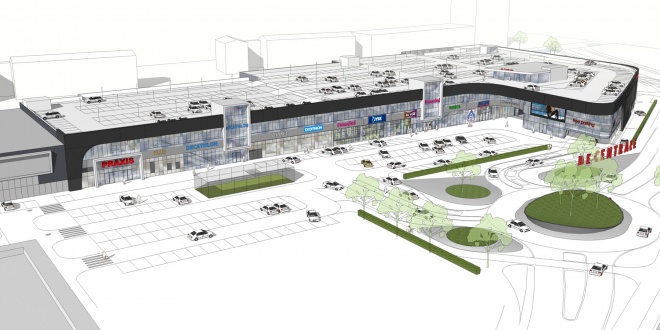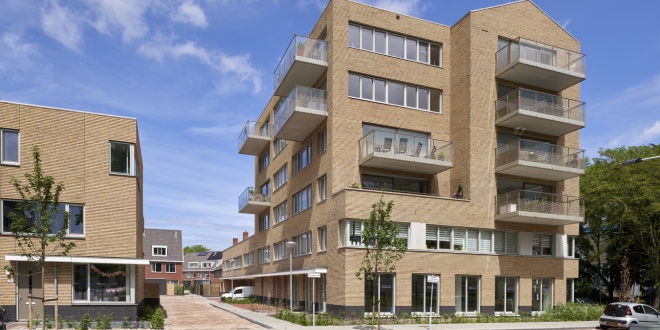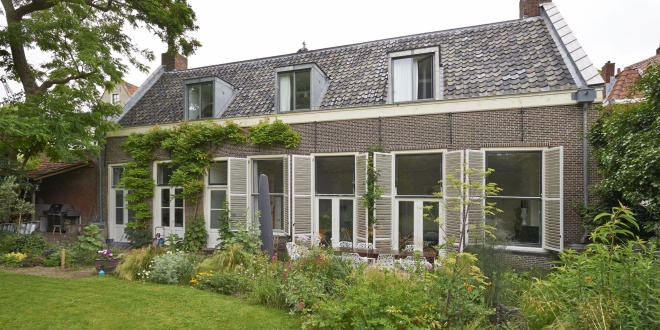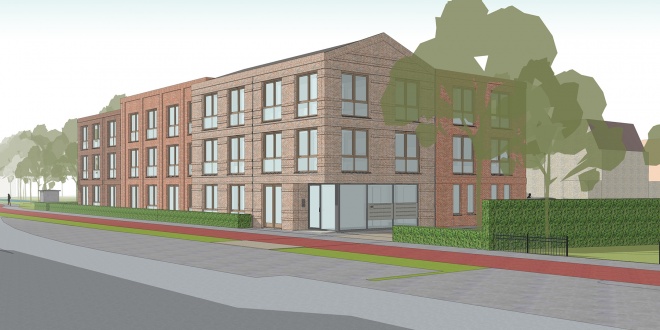The retail park "De Centrale" takes its name from the power plant (PEB) that was located at this location. With the exception of one Nuon building, everything has been demolished and the location is gradually being transformed into shops. The current retail floor area is over 30.000 m2. This makes De Centrale the regional shopping center of Friesland. The planned expansion of 15.000 m² will further strengthen this regional position. The design has a recognizable shape and brings cohesion between the different buildings, a clear public space and a clear entrance. The advertising is an integral part of the design. In anticipation of this expansion, a new KFC branch has been designed and built on the site (2017).
Urban development and architectural integration “Vomar” location, corner of Abraham van Rooijenstraat and Maarten Kruijtstraat in Noordwijk
From an urban planning point of view, the contours and height of the building plan were determined by the municipality of Noordwijk. The plan clearly defines the streets Abraham van Rooijenstraat and Maarten Kruijtstraat, in line with the existing street profiles. Gasthuissteeg will also have a clear boundary with this building plan.
The main mass has an intermediate scale between two worlds present in the environment. On the one hand, there is the smaller-scale village development of the Hoofdstraat and on the other hand, the large-scale hotel development. The mass of the new building block to be built is 3 storeys high plus a roof storey. It is articulated into a number of volumes, softening the scale of the building block. These volumes are made independent by different colors of masonry and roof finishes. With a play of rhythm between balconies, windows, tires, roof moldings and a green-copper-colored roof, the building blends in well with the seaside resort architecture of the environment. The mass on the Gasthuissteeg is 2 storeys high. It has a green facade with window openings. On the north side of the plan, the existing firebreak will be closed and the buildings will close directly on the adjacent plot.
The plan is mainly sustainable because of the triple land use. The building block has an underground floor, on top of that a storey layer, above that a parking deck for the houses and 42 houses.
Abraham van Rooijenstraat is an important access road. That is why functions such as the entrance to the underground parking garage, the entrance to the parking deck on the 1st floor in front of the houses, and the entrance to the expedition have been made here. The Kruisstraat will become more traffic-calmed. This will be the world of shopping as it is at the Hoofdstraat. This is where the shopping functions will be located, which are accessed via two clear entrances at the corners. These entrances are clearly visible from the Hoofdstraat and from the Grent.
The entrance to the houses is on the north side. This will give the existing loading and unloading yard, where other residential accesses are located, a quality impulse. The gallery facade, which is hardly visible from the public space, is conceived as a veranda world. It's a light world of painted wood.
In cooperation with Smits bouwbedrijf, VVKH has won the european tender to develop a new housingarea in district Dieperhout in Leiden. The project consists of 48 dwellings, 12 apartments and a care facility of 1500m². Start of the constructionwork is planned in may 2015, because thats when a current school will move to a new building and the site will be available.
Together with restoration contractor Burgy from Leiden, the back house, the garden house of the house at Garenmarkt 9 / 9a, has been completely restored and modernized. The new owner lives in this part. The front house with a number of apartments / studios for rent will remain unchanged for the time being.
The house at Garenmarkt 9, 9a is also popularly known as 'Thorbeckehuis'. The house has one of the largest private backyards in Leiden. In the Secret Annex, the garden house (No. 9a), the liberal statesman Johan Rudolph Thorbecke wrote in 1848 the revision of the Constitution, which turned our country into a constitutional monarchy. Thorbecke has lead three cabinets from 1849. A gable stone in the national monument reminds of the habitation by the liberal statesman and professor of law (1798-1872).
At the beginning of the Kruisweg, the housing project ‘Gemaalhuis’ marks the entrance to Hoofddorp. In collaboration with Timpaan, RROG Urban Planning and Landscape and IBB, moes have been realized in a place where offices used to dominate in the past.
The design for 83 dwellings near the center of Hoofddorp provides a transition between the village ribbon development along the Kruisweg and the large, urban scale that Hoofddorp aspires to. At the design site, the original polder structure was situated perpendicular to the direction of the rest of the Haarlemmermeer. In the design, a passage has been made here in the building block: a quiet residential court without cars and shared use of public space. The buildings are all-sided, refers to the past and seems to have been there for some time without being historicizing. The architecture is robust and stony. Rich brick details refer to the steam pumping stations that stood at the beginning of the creation of Hoofddorp. The complex is a neighbourhood in itself and has variety of housing typologies; single-family houses, veranda houses, terrace houses and apartments. The apartments are designed as freely divisible lofts.
The homes were completed in June 2020.
Villa Meijendel takes its name from the nature reserve in which it is located, where a forest meets a valley of dunes. The house is constructed from concrete and set into the side of a sandy slope. The building's design aims to create a dialogue with its surroundings, both through the way the form and materials engage with the landscape, and through the use of glass to provide views out from and into the house.
The boxy geometric structure is entirely clad in charred timber, creating a textured black surface that appears different depending on how sunlight falls on it. The exterior finish, inspired by the ancient Japanese shou sugi ban technique, also helps to preserve the wood. Sometimes the house is almost invisible against the dark edge of the forest, sometimes it sparkles in the sunlight because of the glittering charred wood, as such forming a background for the play of shadows of tree trunks and branches. The villa hides and reveals itself in the landscape.
The property has its entrance on a middle level accommodating an office and two bedrooms. Stairs ascend to an open-plan kitchen and living space, and drop down to a master bedroom and gym room.
The living room features a full-height corner window that looks out through the trees towards the dune valley. A lower window facing to the rear and a large glazed surface lining the adjacent double-height circulation area face out onto the forest. At the far end of the first floor, sliding glass doors lead out from the kitchen onto a terrace.
The material palette –concrete, steel and anodised aluminium– was chosen to complement the tones and textures of the surrounding environment. Each material is applied in a raw, untreated form. Internally, the walls are finished with smooth concrete, while the rough-sawn Douglas fir beams supporting the ceilings feature a distinctive grain.
West 8, Adriaan Geuze, is responsible for the garden design.
Photography is by Christian van der Kooy
The plot Oeverpolder is located in the central part of the Hoornespolder, a 1960s reconstruction area. In recent years, this district has undergone a transformation, where living is more focused on the public space and a clearer separation is made between public and private.
In the design for the new-build location, a U-shaped courtyard building was chosen, which in terms of architecture and grain size connects to the existing buildings. The green structure of the neighborhood is reinforced with the design. The transition between the residential building and the public space has been carefully designed. There are no garages, storage rooms and blind facades in the public space. The U-shaped building contains a total of 52 apartments of 53-88 m2. The building on Hoorneslaan has 4 storeys, the other two sides are 3 storeys high. The houses are all accessible via (widened) galleries in the courtyard, parking is partly in the courtyard and partly on public land, on the street.
The masonry architecture is in line with previous transformations on Hoorneslaan, but also fits in well with the existing modern reconstruction architecture of, for example, the adjacent Pniëlkerk. Due to the sloping boundary of the plot on Hoorneslaan, the building block has been given characteristic staggered façades here. It is an all-round designed building that at the same time has a new and unique character, but also fits well in the neighborhood.
The Plantsoen in Leiden is well known for the historical appearance of both the city park (1836) and the houses of the last quarter of the 19th century. The park was originally landscaped on the edge of the city in the place of an old defense belt. At the entrance of the park at the east side the monumental building Plantsoen 1 – 3 is redeveloped in a complex with 6 apartments. The apartments of about 150 m² are provided with all luxury and comfort, such as a private indoor garage, spacious roof terraces and an elevator, while retaining the historical look and value of the building. Redevelopment also applies to sustainability; obtaining Energy label A. Exterior facades, window frames and roof are additionally insulated. The houses are underfloor heated and solar panels are provided on the roof.
The municipal monument at Plantsoen 1 – 3 is divided over three floors and a basement. The property at number 1 was originally a fully detached house, number 3 was part of a block of 3 houses. Both buildings date from 1875 and were connected in 1957 and converted into one large nursing home. In this function change, the original qualities have largely been lost. The round expansion at number 1 dates from 1993.
In the new layout with 6 apartment, the monuments are restored to their former glory by restoration contractor Burgy from Leiden. The façade of the intermediate building is renewed and aligned with the monuments. The existing façade of the round building is finished with a bronze wall cladding, a ‘veil‘ with a leaf motif. This pattern is inspired by the leaf motifs and decorations of the 19th century, which can still be found in various places along the Plantsoen. The round with ‘veil’ becomes a special recognition point in the inner city.
Each apartment has both rooms in the monumental area as well as in the newer parts. The interior of the monumental buildings is provided with appropriate details to bring back the historical character as much as possible. This specific part is provided by Verlaan & Bouwstra architects from Vianen.
On the inside buyers have a lot of freedom of choice; they can choose for an even richer historical finish with wall tension, panelling and en-suite layout or a tight, modern finish and layout; both are possible. Each apartment is unique, has its own layout and its own character. Only the view is the same for all apartments; they all look out over the beautiful monumental city park the Plantsoen at the town canal.
The redevelopment was completed in July 2018.
For the Hoge Rijndijk location in Zoeterwoude, a new construction plan has been developed for an apartment building with starter homes, after demolition of the existing office building. The building stands on the edge of the large-scale buildings that are currently being built between the Oude Rijn and the Hoge Rijndijk, and the existing residential area from the 1980s. It adjacents to a small park on the east side. The new building has been placed in the building line of the Rijndijk and thus strengthens the profile of the road. The parking spaces are located in the rear area, lined by green. By dividing the building mass in three, a smaller scale is created, which is further reinforced with differences in brickwork and roof shape. The building will contain 34 residential units of approximately 50 m2 and a bicycle storage. An extremely energy-efficient and sustainable design is achieved with individual heat pumps and solar panels on the roof.
The permit application is being processed, implementation is expected in 2021.
The plan ‘de Biezenhof’ is part of the new residential area ‘Waterrijk Woerden’ and is situated along a natural watery region. The urban scheme of ‘Waterrijk Woerden’ was designed by West 8 and refers to the traditional Dutch water cities such as Delft and Leiden. The design is made in collabiation with Klunder architects. Almost every dwelling is individual and has a specific connection to the water.
The plan of Biezenhof is divided in two parts: there is one block of family houses around a courtyard on the edge of the lake, and there is a row of water houses and apartments along a canal.
The buyers of the houses could choose between several types of houses as well as between four architects. Due to the possibilities in combining type and architect, not one house is the same. Every house has a singular character: the lake houses have a beautiful view on the lake, the street houses have a garden, and the canal houses enclose big terraces. In the public space there are a few parking places, the majority of parking places are organised in garages.
The houses designed by Knappers are characteristic because of the huge roof overhanging the façade. This contributes to the shelter-against-the water identity of the houses, and refers to the greenhouse glass constructions in the low lands. At the street side these houses are made of brick, which gives them a closed and open (to the light and the water) individuality.
The team with VVKH Architects, Dura Vermeer and Besix has been selected for the design and build of a five-story underground parkinggarage in the historical center of Leiden.
A total of 269 houses and apartments are being built by various parties in the Stelt Zuid, part of the “Waalsprong” near Nijmegen. De Stelt Zuid occupies a special position as a green enclave between the village of Lent and the river. Four combinations of architectural firm and developer work together here on a new residential area, with a central orchard and the dike zone as structuring elements.
Commissioned by BPD, we made the design for 12 dike houses in the dike zone. The houses have a living area of approximately 190 m2 and all have a fantastic view from the living floor over the Waal and the city of Nijmegen. There is parking at the bottom of the houses, on the first floor the master bedroom, kitchen and backyard are situated on the dike, on the second floor the living room with a view of the Waal and the third floor can be set up as a sleeping and / or work space. The houses are gas-free and the roof is fitted with solar panels.
The height differences of the dike area are reflected in the gardens and the transition to the struing area along the dike. From the terrace of the houses you can walk towards the banks of the Waal.
The houses were put on sale in December 2019.
"PURE LIVING"; the winning housing concept for the ‘Klop’ location in Alphen aan den Rijn
Together with Bemog Projectontwikkeling we have developed a vision for 3rd stage of this location in Alphen aan den Rijn. The location is the final piece of the residential area of Kerk en Zanen. It is located on the edge of the Green Heart, with beautiful sight lines on the polders. From the N11, the peripheral buildings will become the first sight of Alphen aan den Rijn.
A sustainable plan has been developed for this location (zero on the meter), which in terms of architecture fits seamlessly into the green environment. The 'Pure Living' concept consists of 40 terrace apartments, 20 water houses, 16 linked villas, a utility and neighborhood facility and a built-in parking facility. The peripheral buildings with the linked water houses and the two apartment buildings form the green boundary of the polder landscape of ‘het Groene Hart’. The greenery of the polder is visually extended into the buildings by giving each apartment its own (terrace) garden. The semi-detached villas are positioned in various ways and are adapted according to buyer's wishes.


















